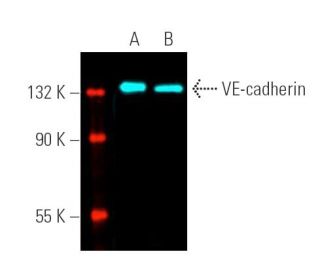
Click on image or enlarge button to enlarge
VE-cadherin Antibody (F-8): sc-9989
- VE-cadherin Antibody (F-8) is a mouse monoclonal IgG1 κ VE-cadherin antibody, cited in 383 publications, provided at 200 µg/ml
- specific for an epitope mapping between amino acids 768-784 at the C-terminus of VE-cadherin of human origin
- VE-cadherin Antibody (F-8) is recommended for detection of VE-cadherin of mouse, rat and human origin by WB, IP, IF, FCM and ELISA; also reactive with additional species, including porcine
- Anti-VE-cadherin Antibody (F-8) is available conjugated to agarose for IP; HRP for WB, IHC(P) and ELISA; and to either phycoerythrin or FITC for IF, IHC(P) and FCM
- also available conjugated to Alexa Fluor® 488, Alexa Fluor® 546, Alexa Fluor® 594 or Alexa Fluor® 647 for WB (RGB), IF, IHC(P) and FCM, and for use with RGB fluorescent imaging systems, such as iBright™ FL1000, FluorChem™, Typhoon, Azure and other comparable systems
- also available conjugated to Alexa Fluor® 680 or Alexa Fluor® 790 for WB (NIR), IF and FCM; for use with Near-Infrared (NIR) detection systems, such as LI-COR®Odyssey®, iBright™ FL1000, FluorChem™, Typhoon, Azure and other comparable systems
- Contact our Technical Service Department (or your local Distributor) for more information on how to receive a FREE 10 µg sample of VE-cadherin (F-8): sc-9989.
- m-IgG Fc BP-HRP is the preferred secondary detection reagent for VE-cadherin Antibody (F-8) for WB applications. This reagent is now offered in a bundle with VE-cadherin Antibody (F-8) (see ordering information below).
QUICK LINKS
SEE ALSO...

VE-cadherin Antibody (F-8) is an IgG1 κ mouse monoclonal VE-cadherin antibody (also designated CDH5 antibody, CD144 antibody or Cadherin 5 antibody) that detects the VE-cadherin protein of mouse, rat and human origin by WB, IP, IF, FCM and ELISA. VE-cadherin Antibody (F-8) is available as both the non-conjugated anti-VE-cadherin antibody form, as well as multiple conjugated forms of anti-VE-cadherin antibody, including agarose, HRP, PE, FITC and multiple Alexa Fluor® conjugates. The cadherins are a family of Ca2+-dependent adhesion molecules that function to mediate cell-cell binding critical to the maintenance of tissue structure and morphogenesis. Cadherins each contain a large extracellular domain at the amino-terminus, which is characterized by a series of five homologous repeats, the most distal of which is thought to be responsible for binding specificity. The relatively short carboxy-terminal, intracellular domain interacts with a variety of cytoplasmic proteins, including β-catenin, to regulate cadherin function. VE-cadherin (for vascular endothelial cadherin, also designated cadherin-5) is localized at intercellular junctions of endothelial cells, where it is thought to play a role in the cohesion and organization of intercellular junctions.
Alexa Fluor® is a trademark of Molecular Probes Inc., OR., USA
LI-COR® and Odyssey® are registered trademarks of LI-COR Biosciences
References:
- Genomic organization and chromosomal mapping of the mouse P-cadherin gene. | Hatta, M., et al. 1991. Nucleic Acids Res. 19: 4437-41. PMID: 1886768
- The cadherins: cell-cell adhesion molecules controlling animal morphogenesis. | Takeichi, M. 1988. Development. 102: 639-55. PMID: 3048970
- Functional properties of human vascular endothelial cadherin (7B4/cadherin-5), an endothelium-specific cadherin. | Breviario, F., et al. 1995. Arterioscler Thromb Vasc Biol. 15: 1229-39. PMID: 7627717
- Desmosomal cadherins: another growing multigene family of adhesion molecules. | Koch, PJ. and Franke, WW. 1994. Curr Opin Cell Biol. 6: 682-7. PMID: 7833048
- Cadherins and catenins: interactions and functions in embryonic development. | Ranscht, B. 1994. Curr Opin Cell Biol. 6: 740-6. PMID: 7833053
- Spatial and temporal relationships between cadherins and PECAM-1 in cell-cell junctions of human endothelial cells. | Ayalon, O., et al. 1994. J Cell Biol. 126: 247-58. PMID: 8027182
- Dynamics of cadherin/catenin complex formation: novel protein interactions and pathways of complex assembly. | Hinck, L., et al. 1994. J Cell Biol. 125: 1327-40. PMID: 8207061
- Morphogenetic roles of classic cadherins. | Takeichi, M. 1995. Curr Opin Cell Biol. 7: 619-27. PMID: 8573335